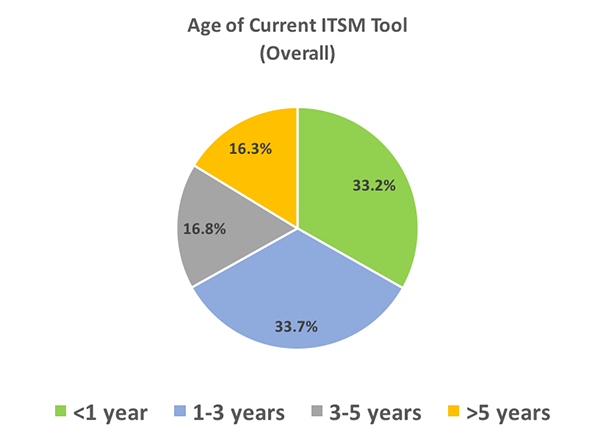Date Published August 16, 2017 - Last Updated December 6, 2017
There was a lot of noise around the 10th anniversary of the iPhone recently. Consider how much that one device has changed since it was released in 2007, and how much more you can do with one now than you could then because of the huge ecosystem around it.
One of the stats we uncovered in recent (2017) research is that about one-third of organizations have an ITSM tool or suite that is more than three years old, and in half of those organizations, it’s more than five years old.
If your organization is using a software-as-a-service (SaaS) or “cloud” tool, age doesn’t really matter that much, because updates are delivered automatically in most cases. The tool you have now is the current version.
If, however, your organization has the ITSM tool or suite installed on the premises (i.e., in your own data center) and it hasn’t been updated or replaced in five years, you might be at a disadvantage.

Source:
The State of Today’s IT
Why? Because technology surrounding that tool has changed. Plugins, application programming interfaces (APIs), connectors, widgets, and other types of tech are most likely designed to work with the latest version of software and may be incompatible with your aging system. The gains these surrounding technologies make are unavailable to you if you aren’t using the current version.
As an example, 31 percent of organizations told us that their current ITSM tool or suite is not available on mobile devices. This post started by noting that the iPhone is now 10 years old.
To be clear: This post is not intended to tell you to rush out and buy something you can’t afford or don’t need. It is encouragement to consider whether the advances of the last few years could benefit your organization and produce a return on investment (ROI).
Here are some questions to ask to help you think about whether you need to update your ITSM tool:
- Do we still adhere to the processes we used when we installed this tool?
- Does the tool support the way we are doing things now (e.g., swarming vs. skill-based routing)?
- Are we using (and licensing) multiple tools where one would do?
- Are there productivity gains we are missing?
- Do we still have the expertise in-house to make adjustments to the tool if/when needed?
On this last point, our research tells us that only 11 percent of organizations have an ITSM tool or suite that is codeless and easy to change. Over one-quarter (26 percent) have tools that require specialized programming, and the remaining 63 percent have tools that require some specific knowledge to administer. If those skills don’t exist on the team, how can you make changes? If you lose your person/people with the expertise, how will you regain it? Succession planning, shadowing, and ongoing training are key to maintaining the skills you need on your team.
Only 11 percent of organizations have an ITSM tool that is codeless and easy to change.

Even if your organization is not currently seeking to change the toolset, you should be conducting a periodic review to determine whether such a change should be considered in the near future. The world of technology is certainly not standing still. It is accelerating at an amazing pace. Frameworks and methodologies are changing as well. Consider how old your systems are in “IT years” and review your practices, processes, procedures and—most importantly—business goals.
 Roy Atkinson is HDI's senior writer/analyst, acting as in-house subject matter expert and chief writer for SupportWorld articles and white papers. In addition to being a member of the HDI International Certification Standards Committee and the HDI Desktop Support Advisory Board, Roy is a popular speaker at HDI conferences and is well known to HDI local chapter audiences. His background is in both service desk and desktop support as well as small-business consulting. Roy is highly rated on social media, especially on the topics of IT service management and customer service. He is a cohost of the very popular #custserv (customer service) chat on Twitter, which celebrated its fifth anniversary on December 9, 2014. He holds a master’s certificate in advanced management strategy from Tulane University’s Freeman School of Business, and he is a certified HDI Support Center Manager. Follow him on Twitter @HDI_Analyst and @RoyAtkinson.
Roy Atkinson is HDI's senior writer/analyst, acting as in-house subject matter expert and chief writer for SupportWorld articles and white papers. In addition to being a member of the HDI International Certification Standards Committee and the HDI Desktop Support Advisory Board, Roy is a popular speaker at HDI conferences and is well known to HDI local chapter audiences. His background is in both service desk and desktop support as well as small-business consulting. Roy is highly rated on social media, especially on the topics of IT service management and customer service. He is a cohost of the very popular #custserv (customer service) chat on Twitter, which celebrated its fifth anniversary on December 9, 2014. He holds a master’s certificate in advanced management strategy from Tulane University’s Freeman School of Business, and he is a certified HDI Support Center Manager. Follow him on Twitter @HDI_Analyst and @RoyAtkinson.